Self introduction in English for students must include a outline that covers the personal details, educational background, area of interest, etc, it shall also provide insights into the personality of a person, their strengths, and their weaknesses. A good introduction of the students will give a presentable remark about them.
Table of Contents
- What is a Self Introduction?
- Samples of Self Introduction for Students
- How to do a Self-Introduction in English as a Student?
- Importance of a Strong Self-Introduction for Students in English
- Key Elements of Self Introduction for Students
- Steps to Draft a Good Self-Introduction for Students
- Important Tips to Prepare for Self Introduction for Students in Engish
- Books to Enhance Spoken English
- Best Practices for Self Introduction for Students
A self introduction for students in English is designed to provide people with a detailed explanation of who they are along with forming any type of relationships or communications. It guides people in understanding an individual in a better way and it also works as an icebreaker while initiating any conversation or contact.
Learning how to give a self-introduction in English is a must for college or high school students as it allows them to communicate or share important information related to themselves confidently, such as their name, background, hobbies, goals, achievements, any many more. Self-introductions are commonly utilized in a variety of settings, including social gatherings, interviews, schools, and professional networking events.
It is a brief statement or speech in which an individual introduces themselves to others. The first thing we do when we are in a new environment is to introduce ourselves to the people there, and students come across this situation at every step of their journey.
What is a Self Introduction?
A person needs to introduce themselves when they are anchoring an event, starting a new job, joining an organization, or meeting new people in social gatherings. A self introduction for students in English typically includes one's name, profession, education, or field of study, and a brief overview of their background and forum-based interests.
A self introduction for students is more than just saying your name and where you're from. It is a chance to present your personality, goals, interests, and achievements in a concise yet effective way. Here's why it's important:
- Builds Confidence: Speaking about oneself improves public speaking and interpersonal skills.
- Creates Connections: It helps classmates and teachers understand you better.
- Essential for Interviews and Exams: It is often asked in viva exams, scholarship interviews, or college orientations.
Samples of Self Introduction for Students
Self introduction for students in English is essential to have clear communication, making students communicate freely and smartly engage their audience. Some of the best self-introduction samples for students in English are listed below for reference:
Sample 1: Self Introduction for Students in College Interview
The situation below explains the students attending an interview session in college and introducing themself to the interviewer and other staff members of the team.
Good morning Sir/Ma'am,
I am Amogh, born and brought up in Bandra. Thank you for allowing me to introduce myself. I scored 77% in my school at Little Flowers Montessori English Medium High School and 77.7% at SSWN Junior College.
My strength is my positive attitude, as I consider failure and success to be ingredients of life, which must go hand in hand. I give my best in the projects I take up and ensure that nothing is left behind. However, I am the first to take responsibility if anything goes wrong.
My short-term goal is to identify my areas of interest, with the clubs that the college has. My long-term goal is to get placed in a high-paying position and a holistic work environment that allows me to learn and implement my ideas. That's all about me, sir.
Thank you for providing me with such an excellent opportunity to introduce myself.

Sample 2: Self Introduction for Students to a Team
Good morning Ma'am/Sir,
I'm Shree, and it's my pleasure to introduce myself. I was born in Himachal Pradesh and grew up in Anandpur. I completed schooling from Little Flower Montessori English Medium High School and am now pursuing my B.Tech from CBT.
My strength is taking up challenges and striving for them. I believe in the mantra of 'Making it Happen'. I believe success and failures are the best way to sculpt ourselves to reach our goals. I believe in myself and the hard work I put into the best of things.
My short-term goal is to achieve excellence in the skills I'm mastering. However, my long-term goal is to be a renowned Technical Engineer.
That's all about me, sir. Thanks for allowing me to introduce myself.
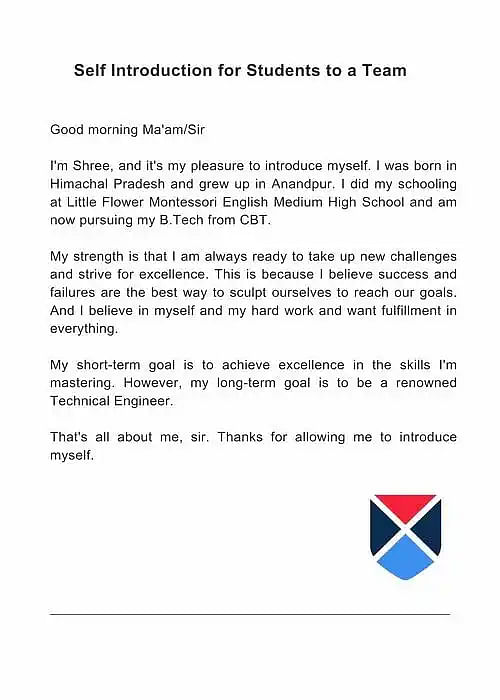
Sample 3: Classroom Self Introduction for Students in English
Hi everyone,
My name is Akhil, and I come from Anna Nagar, Chennai. I am 12 years old, and I look forward to being a part of this classroom.
I am interested in coin collecting and collecting different-sized and shaped leaves, which I get engaged with when I don't have any academic tasks at hand.
My favorite subject is History and my favorite extracurricular activities include painting and pencil sketching.
I am excited to be here with you and can't wait to be a part of this learning environment.
Thank you for listening to me!
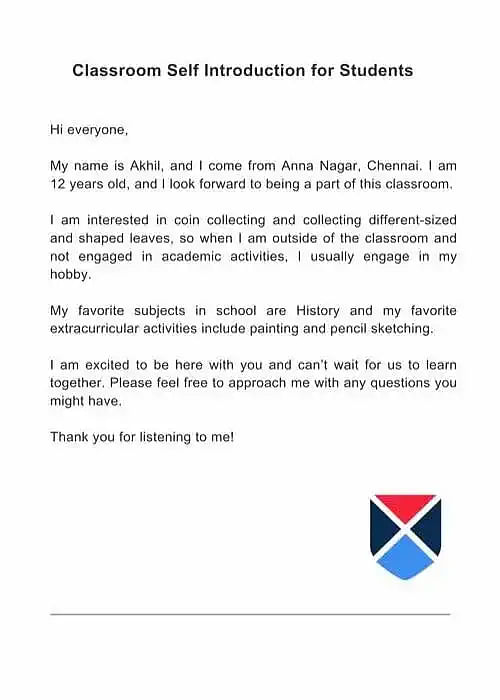
Also Read: 6 Coping Strategies For Student Mental Health
How to do a Self-Introduction in English as a Student?
Tips of self introduction for students in English include greeting the person with a smile, sharing their name and interest, etc. Every candidate has their way of presenting themselves; however, there are a few steps that shall make the process easy and remarkable:
1. Greet with a Smile
Students must start their self introduction in English with a smile on their face and greet the person or audience to whom they are introducing themselves. It shall make others feel good about themselves and the student, and will also develop strong bonds. Greeting someone unknown with a smile will make others comfortable, at ease, and relate well.
2. Begin with the Self Introduction in English
The student should start their self introduction with their 'Name and Place' after the greeting. Let the audience also know about their hometown's speciality, if any. The basic information must be shared initially, i.e., in a chronological manner.
3. Share Educational Details
If the student is introducing themselves in a formal space, they should be brief about their educational details, academic achievements, any curricular achievements, awards and accolades, areas of interest, hobbies, ideas and inspiration. In case of an informal address, students are advised to be brief about their educational qualifications, such as just sharing their current/ highest qualification.
4. Reach Out to the Experiences
Students are also asked to share their prior experience (if any) and recreational activities. They can explain in brief about their tasks, internship details if any, additional technical experiences, and other details. They can also add on the achievements at the university, certification courses they have acquired, and skills they have mastered, for a better impression.
5. End With a Thankful Note
At the end, thank the audience for listening to you patiently. Thank them for giving their time and end the self-introduction in English by expressing thanks to the platform and showing enthusiasm for the opportunity.
Also Read: 10 Prioritization Techniques for Student Productivity
Importance of a Strong Self-Introduction for Students in English
It is important for students to be aware of how to introduce themselves in English as it helps them build their network and improves their confidence level. Here are some of the pointers on the Importance of a Strong Self-Introduction in English for Students in College or School:
- A good self-introduction for students creates an everlasting impression, and people might be urged to listen to or talk to the person introducing themselves. It builds confidence and enhances one's ability to meet new people and present oneself well.
- Moreover, a good self-introduction helps make the atmosphere contented and comfortable to have a conversation. This, in turn, makes a good impression on others.
- Knowing how to introduce themselves helps "break the ice" when meeting new people in any place or situation. Only an individual can know who they are, and it is essential to convey the same to let others know about themselves.
- By knowing themselves, one might build enough confidence to face the world in any situation. Thus, one can work solely on producing a masterpiece and develop a positive approach to life.
Advantages of Self-Introduction for Students in English
Self-introduction helps build a persona and creates an impactful impression on the people one addresses. Students can grab attention and pique interest with a strong introduction. Below are the advantages of self-introduction for students:
- Helps build connections
- Enhances self-confidence
- Sharpens presentation skills
- Builds a favorable impression
- Enhances the ability to meet people
- Deep understanding
- Positive thinking
- Generates motivation
- Enhances communication skills
- One could learn and improve through it
Key Elements of Self Introduction for Students
Listed below are some key elements that must be addressed while preparing a self introduction for students.
- It must contain the full name of the student.
- Students must mention their educational qualifications along with the institutions they pursued it from.
- During an interview, students must talk about their short-term and long-term goals.
- Students must practice speaking their introduction in 1 minute and make it concise accordingly.
- The students must conclude by being polite and summarizing a good word or two about the introduction experience.
Steps to Draft a Good Self-Introduction for Students
Drafting a perfect self-introduction for students includes an outline, header, tone of voice and a brief conclusion. The students can get to know how to draft a good self-introduction using the step-by-step guide given below:
Step 1: Create an outline of the self-introduction
The students must create a synopsis or outline of it with the crux of what points they are going to include in their self-introduction. It will help them decide on what is worth saying and what is not.
Example:
- Greetings
- Full Name
- Where is the student from?
- Educational background (degree or class with the institution's name)
- Interests or Hobbies / Life goals (short and long-term)
- Why did the student choose to be there that day?
- Exciting call to action
- Ending greetings
Step 2: Two points for each header in the outline
The students can write two points in different formats under each header mentioned in the outline. This practice will help them understand which format works better for them. The formats could be formal, informal or semi-formal.
Step 3: Selecting the points from each header
Once the students select the format (formal, informal, or semi-formal) they'll have to go with the same throughout the self introduction. It is important to stay on track to have an effective and good self introduction for students to make a confident first impression.
Step 4: Check the tone of voice and grammar
The students ought to check their tone of voice since it will decide their image and personality in the long run. The self introduction has to be polite and attention-worthy. They can also use free online tools to check the grammar of the content to be spoken.
Step 5: Speak it out loud
The students’ last step is to speak out loud to decide on the timings, the sentence formation, the order of the points spoken during the self introduction etc. Speaking it out loud will help the students to add or remove points to make their introduction more attractive.
Also Read:
- Top 10 Most Effective Stress Management Techniques for Students
- Skill Development Courses List for Students
Important Tips to Prepare for Self Introduction for Students in Engish
The self-introduction for students must be impactful. The points expressed must be precise and clear. It is not necessary to include every trivial information to fill in the gaps in the conversation. Find the list of points and tips for a self introduction for students in English to make an excellent first impression:
- Always greet: By wishing good morning or good evening, a person initiates a conversation and grabs the listeners' attention. It would be better if a student looked confident while starting a conversation.
- Have a purpose: It is necessary to have a better understanding of the motive behind the conversation. Always try to make the conversation impactful and engaging.
- Provide a name: Start by telling your name in a lively voice to make them remember the following words spoken by a particular person.
- Profession: Tell about your work experience, career, or anything related to work. Sometimes it's okay to exclude work experience in the self introduction. However, if there are any internships or part-time jobs, students can include those too.
- Location: Speak about your background and area of residence. One may include a native place and tell about its speciality to help them remember the site.
- Hobbies: One may tell them about hobbies, areas of interest, and activities one gets involved in. This can help to know about nature and lifestyle.
- Aims: Mention the objective of life and give a detailed description.
- Discuss achievements: Include one's achievements in the introduction, and mention what one has achieved till now. Besides, give 3-5 descriptive achievements in the introduction to make it look impactful.
- Favourite or ideal persons: Include one's perfect person in the introduction, and talk about the reason why they motivate you.
- Favourite things, colours, and movies: If the introduction is casual, students may feel free to tell their favourite movies and other favourite places, colours, etc.
- Strengths and weaknesses: Mention strengths and weaknesses in a self introduction. Make sure not to include major flaws, and give a detailed description of the strengths possessed. Remember not to hide your weaknesses and do not boast your strengths.
- Discuss likes and dislikes: One may include their personal preferences or dislikes in the introduction.
- Any life-changing point: Students may include life-changing moments if students want the listeners to engage in their talk.
- Differentiation: In one's introduction, students should speak about their uniqueness and what makes them stand out, which is the essential aspect of self introduction.
- Conclusion: In conclusion, offers an unforgettable answer to the question the spectators possibly will have when they listen to a public speech: what's in it for me? Describe how different life experiences molded your personality, which will be the perfect ending of the self introduction for students.
- Greeting: Say thank you and exit.
Things to Avoid During Self Introduction for Students
The students must know the things to avoid during self introduction to be projected for confidence and make a good first impression. Here’s a list of things to avoid during self introduction for students:
- Avoid being too casual or informal.
- Avoid being disrespectful to the person opposite you.
- Avoid a super lengthy introduction instead try a 1-minute introduction.
- Avoid repeating the contents of your CV or resume.
- Avoid sharing too much personal information.
- Avoid fidgeting while sitting or standing.
Also Read: 10 Tips for Staying Focused and Productive as A Student
Books to Enhance Spoken English
To speak an impactful self introduction in English for students, they must utilize some resources. Students can always refer to and practice with books to improve their language skills. Below is the list of books for enhanced English:
| Books | Authors |
| English Grammar in Use | Raymond Murphy |
| The Blue Book of Grammar and Punctuation | Jane Straus |
| How I Learnt to Speak in English | Neetu Sugandh |
| The Quick and Easy Way to Effective Speaking | Dale Carnegie |
| Spoken English | Vikram Khanna |
| How to Write and Speak Effective, Powerful, and Fluent English | Raj Bapna |
| Word Power Made Easy | Norman Lewis |
| Everyday English for Grown-Ups | Michelle Finlay |
| Eats, Shoots, and Leaves | Lynne Truss |
| Usage and Abusage | Eric Partridge |
| Perks of Being a Wallflower | Stephen Chbosky |
| Deal Breaker | Harlan Coben |
| A Thousand Splendid Suns | Khaled Hosseini |
| Treasure Island Robert | Louis Stevenson |
Also Read: Smarter Study Tips for Students to Ace Their Management Exams
Best Practices for Self Introduction for Students
The students must practice pointers before self-introducing in a public forum. These pointers and tips will help the students to be more conscious during their self introduction:
- Practice and prepare ahead of time before the actual self-introducing event.
- Pay attention to your body language and tone of voice during self introduction.
- Use simple and clear language while introducing yourself.
- Keep practising until you perfect the speech in front of the mirror to be more self-aware.
- Keep eye contact with the group while introducing yourself.
- Keep a timer while practising it and cut short the speech if necessary.
Also Read: 10 Healthy Habits for Students to Excel in Studies

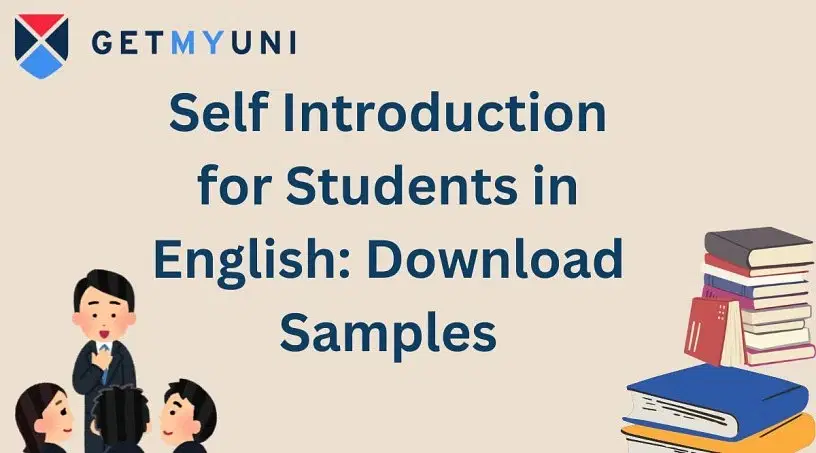




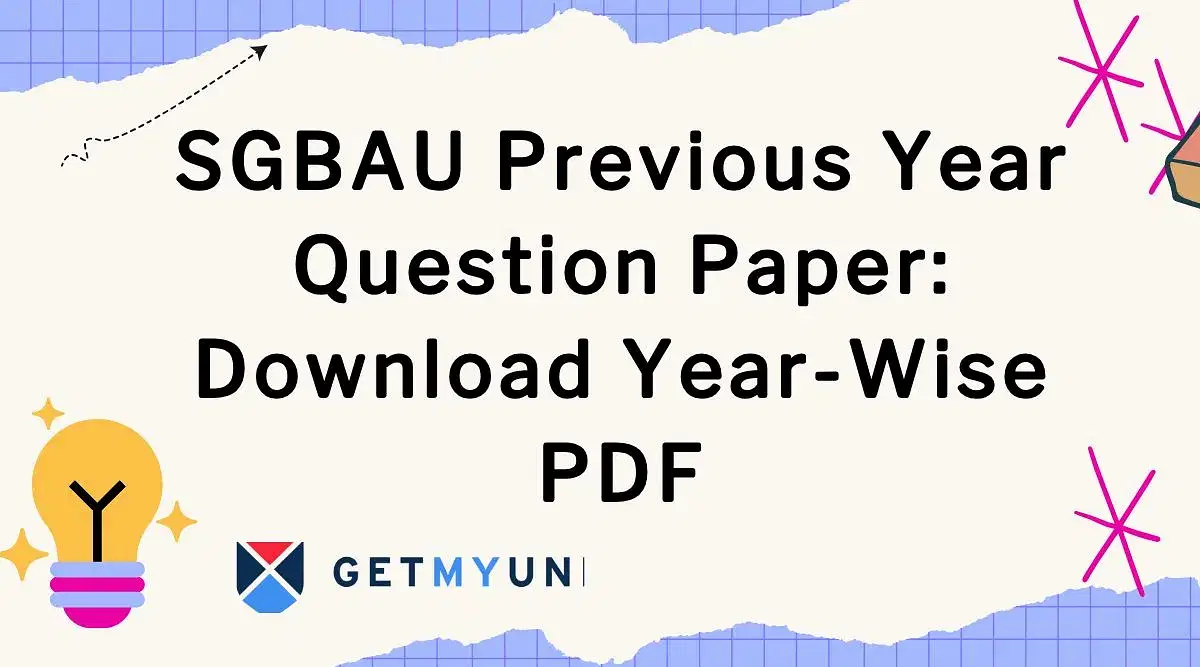






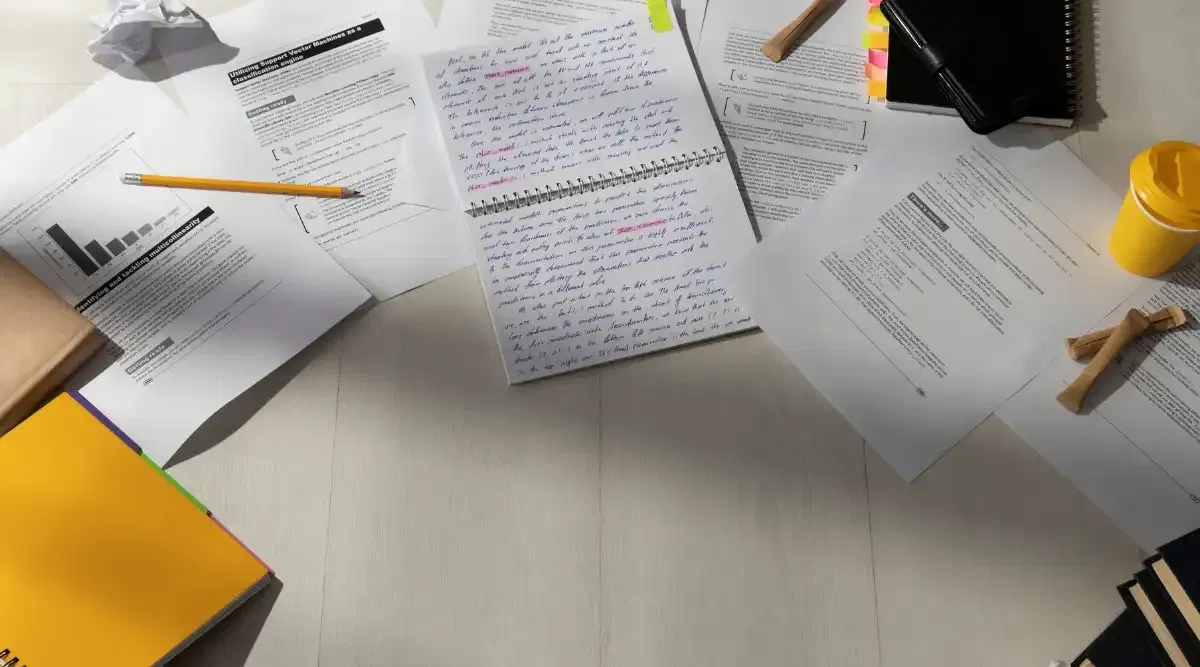






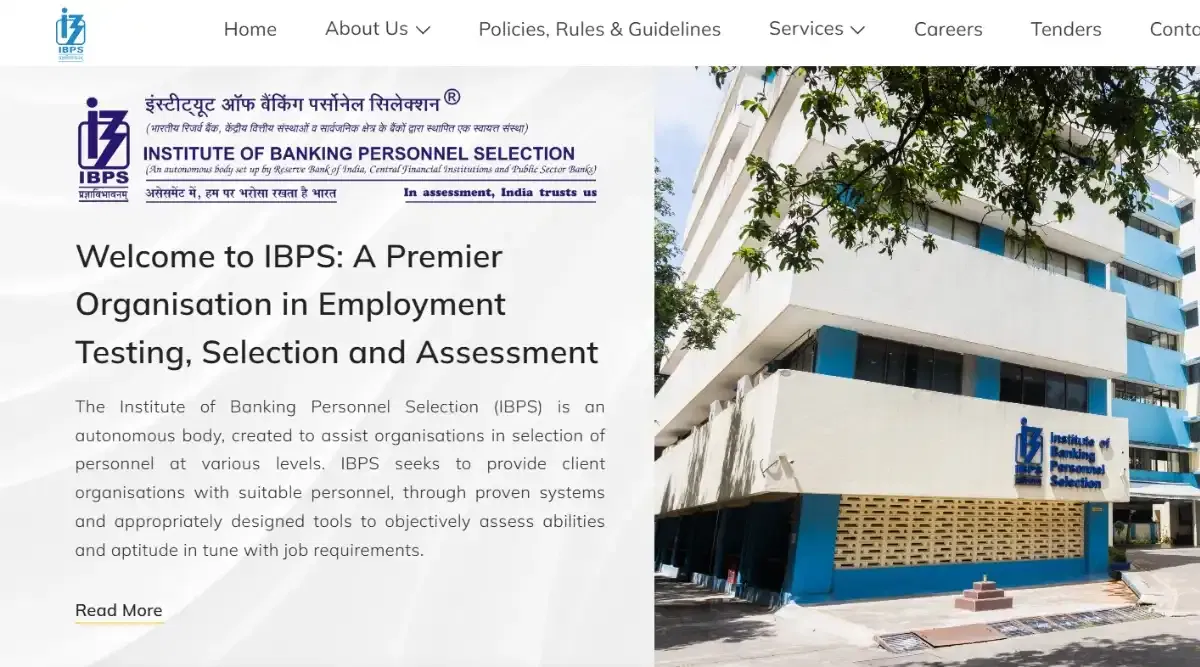


POST YOUR COMMENT